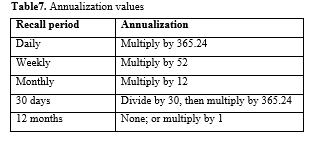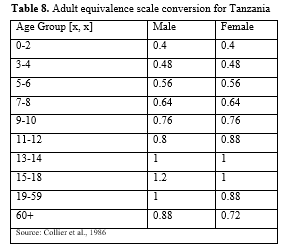You are here
Poverty Rate (Per Capita Household Expenditure)
Poverty rates have been used for over the past half century to provide a monetary measure of household income relative to meeting the household’s basic needs. An international poverty line is set by the World Bank and is used to calculate the number of persons that fall below or above this measure. The World Bank has defined extreme poverty as living below $1.25 (PPP) per day. Rather than income, poverty rate is mainly calculated in developing countries using consumption expenditure to obtain a wealth status of a given (Deaton, 1997). To obtain a per capita measure of consumption expenditure, the value of consumption expenditure by the household on food and non-food items is then divided by the number of household members. Poverty indicators, such as 1) head count ratio (percentage of people below the poverty line), 2) poverty gap (estimates of the ‘depth’ of poverty), and 3) measure of income inequality among the poor (“gini index”; see Foster et al., 1984) are then estimated.
How to operationalize the metric
Method of data collection and data needed to compute the method:
The most popular approach for measuring poverty at the household level is the use of consumption and expenditure surveys. To calculate per capita expenditure through consumption expenditure, the following data are required;
- Food consumed at home (value of food: price and quantity of each item in local units and currency);
- Food purchases (quantities and prices of food purchased for consumption, for example 2 kg of meat at a price of 3000 shilling per kg or purchased meat at a value of 6000 shillings);
- In-kind food consumption (value of in-kind food, e.g., maize flour provided to the household by a neighbor);
- Household demographics (size, age, gender);
- Adult equivalence scales;
- Non-food purchases (e.g., wood fuel, petroleum);
- Consumer price index (CPI) for the respective country in specific currency (current year local CPI and local CPI for 2005);
- United States dollar purchasing power parity for 2005; and
- International poverty line.
Once the data on food consumed at the home, food purchases, and in-kind food consumption have been obtained (see NBS, 2014; section J: consumption of food over past one week), determine the value of each source of food procurement. Sum up the value of each item for each household. The output is the household number in the column and the values in local currency of the 1) value of food consumed at home, 2) value of food purchases, and 3) value of the in-kind food consumption. These values are normally reported using a 7-day recall period to obtain the total household expenditure on food items, sum up the three values for each household (food consumed from own production, household purchases, in-kind food values), and then multiply this value by 52 for an annualized value. For each household, we have a dataset for “household food expenditure (by value)”.
The next step is to calculate the value of non-food purchases. This is termed “Non-Food Expenditures” in the LSMS household survey of Tanzania 2012-2013 (NBS, 2014) as an example of the items it constitutes.
First, determine the monetary value for each non-food item purchased., . These are mainly listed in terms of their recall period. This will be needed to calculate the total annual expenditure for that item. For example, if a household spent $100 a month on electricity and $10 a week on public transportation, a different annualization value will be used.
From this step, once the value of all non-food purchases has been calculated and stored, we annualize the value of each item by multiplying that value by the recall period (see Table 7). Sum all the values for the non-food purchases for each household to obtain the “household non-food expenditures (by value)”.
Next, calculate the household’s adult equivalence from the demographic data on the household members(e.g., age and gender). Different countries have different scales and Table 8 shows an example of one from Tanzania (Collier et al., 1986). Each household member is first grouped into these categories by age and gender and then multiplied by the adult equivalence weight. These weights are summed up across the household to obtain the household’s total adult equivalence.
At this stage, you will have calculated the;
- Households adult equivalence
- Household food expenditures
- Household non-food expenditures
- Household size.
From “1” and “2” above; sum up the non-food expenditures and household food expenditures to obtain the household total expenditures in local currency. To obtain the per capita household expenditure, divide the household total expenditure by the household size. If you want to obtain the per capita expenditure per adult equivalence, divide the total household expenditure by the household adult equivalence.
At this point, we need to convert this value to 2005 United States Dollars and compare it with the 1.25 poverty line (please note that these lines may change but the UN and World Bank will publish this data). To make this conversion, you need the purchasing power parity exchange rate for that country (http://iresearch.worldbank.org/PovcalNet/PovCalculator.aspx ) and the consumer price index (CPI) for that country (say Tanzania) for the year of the survey and for 2005.
To deflate the value of that per capita household expenditure to 2005 local currency (LC) we compute
![]() Then to convert this to the USD 2005 using the purchasing power parity conversion
Then to convert this to the USD 2005 using the purchasing power parity conversion
![]() Equation 4 converts that per capita expenditure to USD for comparison with the 1.25 USD per capita line.
Equation 4 converts that per capita expenditure to USD for comparison with the 1.25 USD per capita line.
Unit of analysis:
The unit of analysis is the per capita consumption. The algorithms for analyzing data to estimate in the number of households below the poverty line has been provided in the literature (Deaton and Zadia, 2002; Deaton 1997; Foster et al. 1984) and have also been applied by organizations such as World Bank in their current analysis of LSMS data sets. To estimate the head count ratio, or percentage of household below the poverty line, the FGT (Forster et al., 1984) algorithm is used where
![]() where H is the number of households below the poverty line (1.25 USD) and N is the total number of household in that sample.
where H is the number of households below the poverty line (1.25 USD) and N is the total number of household in that sample.
Limitations regarding estimating and interpreting:
Poverty rate estimation may be expensive since it requires data collection across various food and non-food items. Measures such as the asset-based wealth index may be less expensive proxy measures for wellbeing. The Progress Out of Poverty measure (Desiere et al., 2015) has been proposed but it suffers from low variability over time and might work best for one-time ‘quick and dirty’ measures. It is similar to the asset-based measure in terms of data collected.



